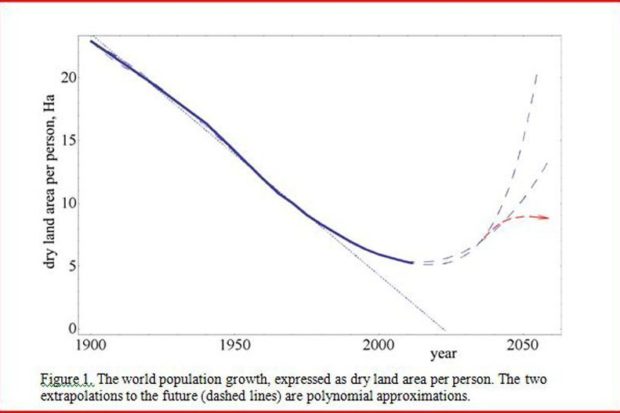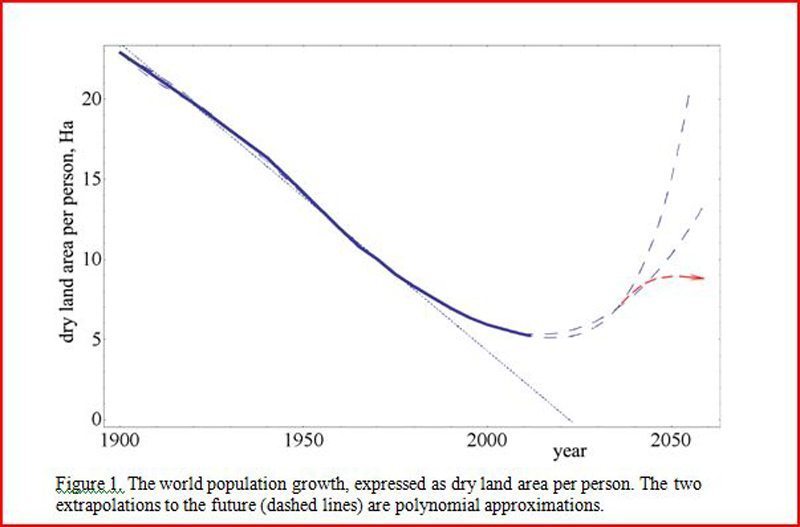
By Alexey V. Byalko and George B. Kauffman


The humorous statement, “It is difficult to make predictions, especially about the future,” including its numerous variants, has been ascribed not only to Yogi Berra but also to persons as disparate as Casey Stengel, Niels Bohr, Mark Twain, George Bernard Shaw, Sam Goldwyn, Will Rogers, Winston Churchill, Benjamin Disraeli, Dan Quayle, Albert Einstein, Victor Borge, Groucho Marx, Enrico Fermi, Woody Allen, Freeman Dyson, Confucius and Cecil B. De Mille (http://larry.denenberg.com/predictions.html).
However, we can make a probable prognosis of the world’s development with reasonable accuracy. There are at least three global indicators that can be reliably measured—1) the Earth’s climate, 2) the world’s population and 3) the sum of knowledge accumulated by humanity throughout its entire history. Their time dependencies are different, but all of them are inertial, that is, they cannot change abruptly. Therefore, analysis of the past can provide a prediction of the future.
Now, however, we are faced with an unprecedented situation. We cannot predict the world future for more than one generation ahead. The more distant future depends greatly on our actions in the next decade or two. Reasonable solutions look extremely difficult to carry out economically. However, unless steps are taken soon, the future collapse of our civilization means no future at all.
Three Views of the Future and Three Bases for Them
People generally have three different opinions about the future—1) the Conservative: “Tomorrow will be about the same as today, but it would be better if it were like yesterday,” 2) the Progressive: “Everything will grow infinitely; human progress is unlimited,” and 3) the Alarmist: “A catastrophe is coming; get ready.”

The conservative view is probably based on the climate stability that has existed for the past 6,000 years, which coincides approximately with the age of written civilization. The progressive view is based on the actual progress of humanity during this entire period. An example of this prognosis is that of Dr. Michio Kaku, a prominent theoretical physicist, bestselling author and host of the Science Channel TV show, Sci Fi Science, and two radio programs. Although Kaku’s prognosis of scientific advances is favorable, his predictions about the environment are decidedly negative—by 2100, several major American cities will be underwater, and others, including New York, will be surrounded by looming seawalls.
The alarmist view is based on quite different reasons. The most obvious one is the inevitability of death. (Because we’re concerned with global development, we’ll dispense with this reason.) There are many global events in life, some of which can lead to catastrophes that are either poorly predictable or completely accidental. For example, earthquakes are both unpredictable and unpreventable. Volcanic eruptions are predictable but still unpreventable. An asteroid impact is possible to forecast decades in advance, but the technology that could influence its trajectory is still far from reality.
Finally, there’s another natural cause for the coming global catastrophe—world population growth. This isn’t a problem that is widely discussed. However, because it can influence our minds and decisions, even when not recognized or expressed openly, we’ll discuss it first.
World Population
The world’s human population has been known with reasonable certainty since the days of ancient Rome. Except for the bubonic plague outbreak (“Black Death”) of the 14th century, this number has increased hyperbolically according to the differential equation proposed in 1959 by the Austrian-American physicist-philosopher Heinz von Foerster. Because an increase of this magnitude is not observed for other species (either flora or fauna), it is caused by humans.
Because the steep graph of von Foerster’s law is difficult to analyze, let’s look at its inverse variant—the dry land area per person (Figure 1). Here the solid line presents actual data; the dotted line is based on Foerster’s law; and the two dashed lines are approximations, which cross at about the year 2037, after which our predictions become unreliable. The red line is Byalko’s prediction for the distant future when the world’s population crisis finally ends. Byalko’s prediction has not been proven mathematically.
Because the time scale for population changes is one generation, that is, 25–30 years, our predictions for the future are limited. This is a mathematical argument but yet not purely mathematical because the change of generations is our human reality. However, there is another serious reason for the coming crisis—global climate warming—which we shall discuss in Part 2.
*****
Alexey V. Byalko, Ph.D. in astrophysics and cosmology; associate fellow, Landau Institute for Theoretical Physics, Russian Academy of Sciences (RAS), Chernogolovka, Moscow Region; deputy editor-in-chief of the journal Priroda (Nature) of the Presidium of the RAS since 1993; and author of the book, Nuclear Waste Disposal: Geophysical Safety (CRC Press: Boca Raton, Fla., 1994), and more than 200 articles.
George B. Kauffman, Ph.D., chemistry professor emeritus at California State University, Fresno, and Guggenheim Fellow, is a recipient of the American Chemical Society’s (ACS) George C. Pimentel Award in Chemical Education, the Helen M. Free Award for Public Outreach and the Award for Research at an Undergraduate Institution, as well as numerous domestic and international honors. In 2011, he was appointed an ACS fellow.
Evidence Mounts on Climate Change
By George B. KauffmanThe article “Connect the Dots: Climate Change and 350.org” (Community Alliance, July 2012) pointed out the need to reduce the limit of atmospheric carbon dioxide to 350 parts per million to avoid runaway climate change. Since then, despite the persistent denial by the well-funded rogue fossil-fuel industry (Have you seen the TV ads for “clean coal”?), the overwhelming scientific evidence for anthropogenic (human caused) climate change continues to mount. Here are a few examples.
“Continuing drought, heat bring fear of global food crisis” (www.commondreams.org/headline/2012/07/19).
“How the Influence Industry Killed Climate Change Legislation” (billmoyers.com/2012/07/21/how-the-influence-industry-killed-climate-change-legislation).
In what he called “the most important thing I’ve written since 1989,” Bill McKibben, whose organization, 350.org, was the focus of the aforementioned article, admitted that the situation was much worse than he had thought: “Global Warming’s Terrifying New Math: Three simple numbers that add up to global catastrophe and that make clear who the real enemy is” and “June broke or tied 3,215 high-temperature records across the United States. That followed the warmest May on record for the Northern Hemisphere—the 327th consecutive month in which the temperature of the entire globe exceeded the 20th-century average, the odds of which occurring by simple chance were 3.7 × 10-99, a number considerable larger than the number of stars in the universe” [0, followed by 99 zeros and 3.7]. (www.rollingstone.com/politics/news/global-warmings-terrifying-new-math-20120719).
“Summer of Solidarity: This summer, climate activists all over the United States confronted the fossil fuel industry with bold and courageous direct actions” (www.350.org/sos/?akid=2113.499873.jXOKMT&rd=1&t=1). Log onto this site to find out what and where actions are being taken.
“‘Not a Mistake’: NASA in Disbelief over Rate of Melting Ice: Greenland ice sheet melted at unprecedented rate during July” (www.commondreams.org/headline/2012/07/25-0).
“Survey: ‘Climate Skeptics’ More Likely to Embrace ‘Free Market’ Ideology, Conspiracy Theories: New study shows correlation between so-called ‘skeptics’ and tendency towards ‘conspiracist ideation’” (www.commondreams.org/headline/2012/07/27).
“Storms Threaten Ozone Layer over U.S., Study Says” (www.nytimes.com/2012/07/27/science/earth/strong-storms-threaten-ozone-layer-over-us-study-says.html?pagewanted=all).
“Climate Study Forces Koch-Funded Skeptic to Admit Humans Driving Warming” (www.commondreams.org/headline/2012/07/29-0).
“Extreme Weather Events Linked to Climate Change: Research shows that some episodes of extreme heat and/or drought linked to human-induced global warming” (cen.acs.org/articles/90/i31/Extreme-Weather-Events-Linked-Climate.html).
“‘When It Rains, It Pours’: Global Warming Brings Increased, Heavier Storms. Report documents increasing and heavier snowstorms and rainstorms since 1948” (www.commondreams.org/headline/2012/07/31-4).
“Scientists Tell Senate Panel: Climate Change Is Here and Disaster Costs Will Be Huge” (www.commondreams.org/headline/2012/08/01-4).
“Boxer Statement: Update on the Latest Climate Change Science” (epw.senate.gov/public/index.cfm?FuseAction=Majority.PressReleases&ContentRecord_id=e2bab1e9-802a-23ad-4fdc-aa5616f99d2a).
“Stop This Culture of Paying Politicians for Denying Climate Change. Protecting the environment requires a sweeping reform of political funding, only then corporations will stop throwing big money at senators” (www.guardian.co.uk/environment/georgemonbiot/2012/aug/02/climate-change-political-funding-us).
“Thousands of Fish Die as Midwest Streams Heat Up” (http://abcnews.go.com/US/wireStory/thousands-fish-die-midwest-streams-heat-16934379#.UB7whY5OjzU).
Things are obviously worse than ever. If you’re a pessimist, this is terrible news. If you’re an optimist, we’ve reached a tipping point, where even the most skeptical will be forced to admit that they were wrong, and something will finally be done. At present, the situation reminds me of Emperor Nero’s fiddling while Rome was burning. (The story is apocryphal, but the metaphor is a useful one.)
However, a crucial factor to avoiding climate disaster is apathy and concern with trivia on the part of the public, the news media and politicians. According to a recent Media Matters for America study by Shauna Theel, the reality-TV Kardashian family got 40 times more major U.S. news coverage than ocean acidification, sometimes dubbed global warming’s “evil twin” (mediamatters.org/blog/2012/06/27/study-kardashians-get-40-times-more-news-covera/186703).
In 2010, during the Kavli Prize Science Forum in Oslo, Norway, U.S. presidential science adviser John P. Holdren said, “Global warming is a dangerous misnomer. It suggests that the changes are uniform, primarily about temperature, gradual and likely benign. None of these are true.” He suggested the designation “global climate disruption.” Perhaps a name change will help, but I doubt it.
I e-mailed my article to numerous colleagues, and one of them, Dr. Alexey Byalko agreed with me that probably the number problem for our survival as a species is how to stop the increase in population and that 350 p.p.m. was a safe upper limit for atmospheric CO2 but pointed out that this goal was unattainable until 2100 if even then. Our ensuing correspondence concerned the possibility of predicting the future and resulted in the two-part article appearing in the September and October issues of the Community Alliance, based largely on Dr. Byalko’s research and calculations, which appear here for the first time in a popular newspaper in English.
